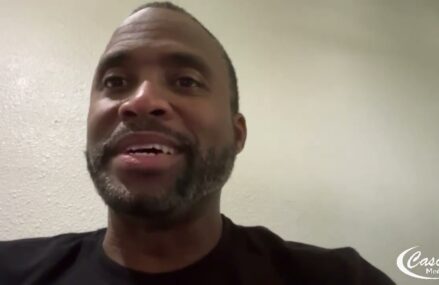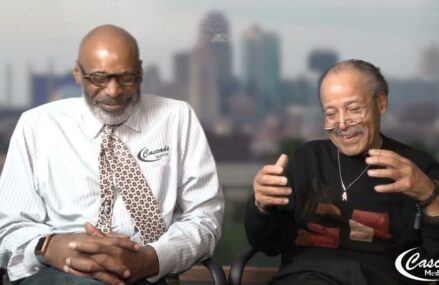By ALBERTO ARCE
FILE – In this undated file image obtained by the Associated Press on Feb. 14, 2013, a man lies on the ground surrounded by unidentified people. On Jan. 9, 2013, neighbors of Kevin Said Carranza Padilla, 28, known in the gang world as “Teiker,” saw police come and take him and his girlfriend without a shot. The next morning, Jan. 10, Honduras’ major newspaper, El Heraldo, reported that police had captured Carranza in connection with the murder of a police commander months earlier, publishing this photo of a shirtless, tattooed young man lying on the ground, his hands behind his back, his face partially wrapped in blue duct tape, the roll still attached. Carranza’s mother, Blanca Alvarado, recognized him from his tattoos. (AP Photo, File)
TEGUCIGALPA, Honduras (AP) — In an Associated Press story about a Honduran gang member who disappeared in police custody, the gang member’s middle name was misspelled because of a typographical error during editing. The correct full name is Kevin Said Carranza Padilla.
A corrected version of the story is below:
Honduras police accused of death squad killings
Honduran gang member missing after police arrest suggests pattern of forced disappearances
By ALBERTO ARCE
Associated Press
TEGUCIGALPA, Honduras (AP) — The operation was quick and under the cover of night. Armed, masked men arrived in late-model SUVs, getting through the gate into the small neighborhood of humble homes. Without firing a shot, witnesses said, they took Kevin Said Carranza Padilla, 28, known in the gang world as “Teiker,” and his girlfriend, Cindy Yadira Garcia, 19.
The next morning, Jan. 10, Honduras’ major newspaper, El Heraldo, reported that police had captured Carranza, a leader of the 18th Street gang suspected in the shooting death of a police commander months earlier. It also published a photo of a shirtless, tattooed young man lying on the ground, his hands behind his back, his face partially wrapped in blue duct tape, the roll still attached. Carranza’s mother, Blanca Alvarado, recognized him from his tattoos.
The photo was distributed to media by a police prosecutor, according to three sources who didn’t want to be named for security reasons. Soon after, agents at the national criminal investigations office acknowledged that there was a detention order for Carranza, and he had been brought in.
More than two months later, Carranza and Yadira have disappeared, The Associated Press has found. They are not in police custody and there are no criminal proceedings against them. Police now say they know nothing about the case.
“At this point,” said Carranza’s mother, “one can only imagine that they are dead.”
Police have long been accused of operating more like assassins than law enforcement officers in Honduras, but few cases ever have been investigated. In the past year, police were alleged to have been involved in the deaths of a prominent Honduran radio journalist and the son of a former police chief — but neither killing has been solved.
Despite millions of dollars in U.S. aid to Honduras aimed at professionalizing the country’s police, accusations persist.
In the last three years, the AP has learned, Honduran prosecutors have received as many as 150 formal complaints about death squad-style killings in the capital of Tegucigalpa, and at least 50 more in the economic hub of San Pedro Sula. The country’s National Autonomous University, citing police reports, has counted 149 civilians killed by police in the last two years, including 25 members of the 18th street gang.
Even the country’s top police chief has been charged with being complicit.
In 2002, a police internal affairs report accused then police prison inspector Juan Carlos Bonilla of three extrajudicial killings — and linked him to 11 more deaths and disappearances that it said were part of a police policy of “social cleansing.” He was tried and acquitted on one of the three charges. The head of internal affairs unit who produced the report, Maria Luisa Borjas, was expelled from the department, and the rest of the cases, like most crimes in Honduras, were not investigated.
Last year, Bonilla was chosen to lead the national police force despite unanswered questions about his past. The U.S. Congress decided to withhold State Department funding to the police while they investigated the 2002 internal affairs report. Roberta Jacobson, assistant secretary of state for western hemisphere affairs, said last week that the department is constantly reviewing information about people and institutions receiving support in Honduras, and so far, the state department can and will continue funding and training the Honduran police.
All but about $11 million has since been released based on a Congressional agreement with the State Department over how counterdrug operations involving the U.S. and investigations into civilian casualties are carried out.
“It has been made clear to the State Department that no units under General Bonilla’s control should receive U.S. assistance without credible information refuting the serious allegations against him,” said Sen. Patrick Leahy, chairman of the Senate Appropriations Subcommittee on the State Department and Foreign Operations.
While U.S. aid is supposed to go only to vetted units, not the entire police force, Leahy said the Carranza case is still troubling. “There is a chronic pattern of human rights abuses, and impunity for those responsible,” he said.
AP interviews with family, witnesses and law enforcement officials paint a picture of a case in which two people associated with gangs were taken into police custody and then never heard from again.
After witnesses told Alvarado, 50, that her son had been taken by police, she went to a series of police stations in search of him. At the National Criminal Investigations Office, she was met by 20 officers, some masked, who openly played with their guns as she asked after her son and his girlfriend.
“You can look for those dogs in the Tablon,” Alvarado said they told her, referring to a lot outside of the city where bodies of the executed are regularly dumped, their faces taped and hands and feet tied. Honduras has the highest murder rate in the world.
The modus operandi in death-squad style killings does not vary much: masked men in bulletproof vests, traveling in large vehicles with tinted windows and no plates, roam the city in groups of 10, said an official in the Carranza investigation, who also could not be named because of the sensitivity of the case.
A month after Carranza’s disappearance, Honduran media released a surveillance video of a similar case: five young men walking a street at night were stopped and surrounded by masked gunmen with AK-47s who pulled up in a large SUV. The gunmen fired at three men who fled. The remaining two, their hands up in surrender, were made to lie face down on the pavement — and then shot several times in cold blood.
One died instantly. The other is seen still moving after three shots from an assault weapon. He later died at a hospital.
National Police spokesman Hector Ivan Mejia declined to comment on the videotape of the shootings because he said they are under investigation. He also said he knew nothing about Carranza’s case, though he noted that Honduras is in the grip of gang warfare, marked by groups of assassins acting on behalf of organized crime.
“We’ve detected a group of people carrying out these types of operations and we’re working to resolve them,” Mejia said. “I have no information indicating the state is acting in this manner. If police were involved in these types of crimes, they would be detained. Authorities cannot and should not combat crime in this manner.”
As far back as 1988, the Inter-American Court on Human Rights condemned Honduras for failing to document the fate of detainees and for allowing police to obstruct judges investigating cases, “including threatening them and denying the disappearances.”
Bonilla was appointed police chief last May after his predecessor, Gen. Ricardo Ramirez del Cid, was ousted amid charges that police were involved in the kidnapping and the killing of one of Honduras’ best-known journalists, Alfredo Villatoro.
Less than a year later Ramirez’s own son was killed. Ramirez called Bonilla the prime suspect in the Feb. 17 assassination of Ramirez’s 17-year-old son, Oscar, killed in a shootout between his bodyguards and 10 hooded gunmen who entered a restaurant where they were eating.
Ramirez said Bonilla was nearby when it happened, though Bonilla has denied any involvement. President Porfirio Lobo has called Ramirez’s comments imprudent.
Honduras made a failed attempt to purge its National Police of corrupt officers after some were implicated in the 2011 murder of the son of Julieta Castellanos, rector of the National Autonomous University of Honduras.
Between May and November, hundreds of police officers underwent background checks and polygraphs. By the end of the year, 33 of them were removed, but the Constitutional Court stopped the purge, ruling that it violated officers’ rights.
One problem in Honduras is that the prosecuting arm of government, the Public Ministry, relies on the criminal investigations department to investigate crimes. But the members of that agency are police officers, which means in the case of death squads, police would be investigating themselves.
The Honduran police force “appears to be an institution that is absolutely beyond reform,” said Victor Meza, president of the Commission to Reform Public Security.
Critics say the Carranza case is evidence of that.
Carranza and his girlfriend had only lived in the modest complex a month when they disappeared.
A neighbor agreed to tell the AP what happened the night of Jan. 9 on condition that his identity would not be made public. The neighbor said he heard noises around 9:30 or 10 p.m.
“They shouted that they were police. There were several, judging from the footprints they left in the flowers. They opened the gate, there was noise for a few minutes, like kicking, and then they left,” he said. Neighbors said someone must have let them through the locked gate.
Gang lookouts alerted a fellow 18th Street gang member, who calls himself Jonathan Flores, a driver for Carranza. Flores said he was the first to arrive after the couple was taken. The door to Carranza’s house was left open.
“The house was ransacked and the dog was alone,” Flores said. “The neighbors told me it was quick, with no shouts or shots fired.”
As he left he saw two Nissan SUVs without license plates, and six or seven masked men in civilian clothes with bullet-proof vests and large guns chatting with the neighbors. Carranza’s mother said they came back to rob the house, taking a 50-inch plasma television, a home theater screen and speakers, cellphones, Carranza’s collection of tennis shoes and about $500 in cash that gang members typically have on hand.
Flores said the police are the only explanation for Carranza’s disappearance. He and others would know if Carranza had been taken by a rival gang.
“Look at the detention photo,” he said. It shows the feet of the people surrounding the prone suspect. “A gang member doesn’t work in officials’ shoes.”
Nor does Flores believe that Carranza fled.
“He didn’t have a motive. Things were working well here,” Flores said. “And he would have told his mom.”
His mother, Alvarado, filed a complaint with the prosecutor’s Office on Human Rights, using the newspaper photo as proof. The unidentified official close to the investigation said the duct tape over the face and marks on the body, including what appears to be a dislocated elbow, would constitute torture.
The human rights prosecutor waited the 48 hours required by law and visited the morgue in an unsuccessful search for a corpse. After that, he made a habeas corpus request with the Supreme Court. The law requires verification of a detention within 24 hours if the person hasn’t appeared before a prosecutor or a judge, the official said.
The Supreme Court has yet to respond. But the official close to the investigation says police acknowledged the day after the disappearance that there was a detention order for Carranza and said he would be processed quickly. Police later denied any knowledge about Carranza.
“A police officer cannot do this on his own,” the official said. “You need a network of information and collaboration to carry out the arrest and disappearance of people.”
___
Associated Press writers Luis Alonso Lugo in Washington and Katherine Corcoran in Mexico City contributed to this report.



